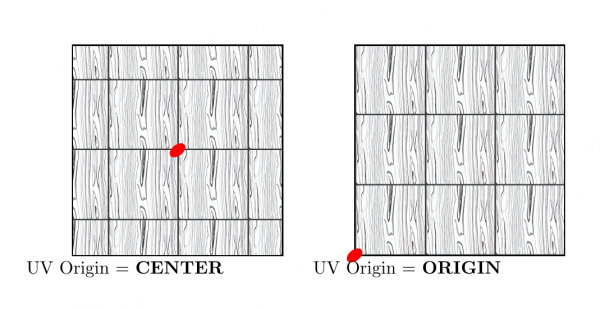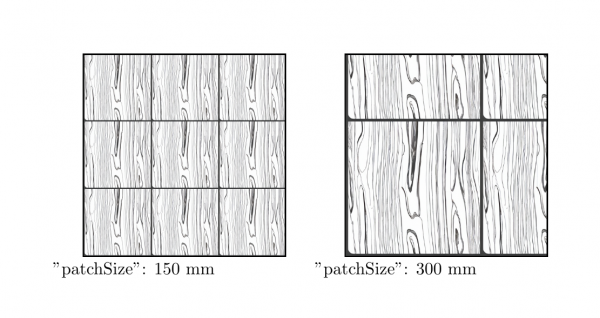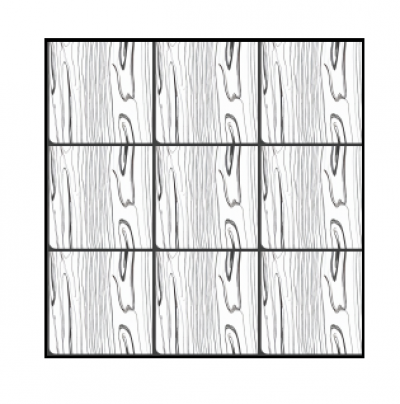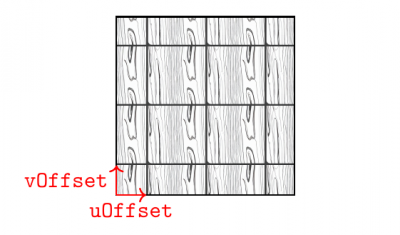UV Coordinates
Configuring UV Mapping Parameters with JSON
The UV coordinates generated by this software are suitable only for seamless textures. If you intend to use the generated geometry with baked textures, it is recommended to export the geometry as a watertight solid in the .OBJ format and unwrap it manually. You can do this using the –no-uvs command. The .OBJ format produces a mesh with a closed volume that can be more easily unwrapped in software such as Blender. The uv object can be specified globally or inside the frame“:[….] array or inside innerPanel object.
[] *Figure: UV settings block in JSON used globally*
"uv": {
"patchSize": 150,
"uvOrigin": "ORIGIN",
"uOffset": 0,
"vOffset": 0
},
The section provided here is an example of a JSON object representing the UV mapping parameters. The uv key contains an object that holds the UV mapping properties.
The properties inside this object (e.g., patchSize, uvorigin, uOffset, vOffset, rotation) are key-value pairs that define the configuration for UV mapping.
All of them override the global values are optional.
[ array]]
*Figure: UV settings block inside inside the frame”:[….] array*
"frame": [
{
"board": "1",
"position": {
"x": 0,
"y": 0
},
"profile": "board",
"uv": {
"patchSize": 150,
"uvorigin": "ORIGIN",
"uOffset": 0,
"vOffset": 0
"rotation": 90
}
},
{
"board": "2",
"position": {
"x": 609.6,
"y": 0
},
"profile": "board",
"uv": {
"rotation": 0
}
}, ......rest of boards..............
]
UV Mapping ("uvOrigin")
The following parameters control how UV coordinates are generated for seamless texture mapping in 3D models. These options are provided in the JSON configuration and are interpreted in millimeters (mm).
uvOrigin(string):
Defines the starting point (origin) of the UV coordinate system when unwrapping the surface of a 3D object. This affects where textures begin when mapped onto geometry.
CENTER: (Default) The UV origin is centered on the surface (i.e., at the middle of the x-z plane), as in the legacy Model Solid 1.0 implementation.ORIGIN: The UV origin is aligned with the (0, 0) coordinate of the local object space, typically the lower-left corner.
If the uvOrigin field is missing or invalid, CENTER is used as the fallback behavior.
| Figure 21: UV Origin Comparison |
|---|
 |
| Caption |
| Isometric view of a 3×3 checker tile. Left: UV origin at the tile center. Right: UV origin at the lower-left corner. |
UV tile scale ("patchSize")
Determines the scale (tiling size) of the UV texture patches. This controls how large a texture appears when applied to a surface.
patchSize(float, in mm):
- Default: 150 mm
- Values that are too small or too large may be flagged as potentially meaningless depending on context.
| Figure 22: Patch Size View |
|---|
 |
| Caption |
| Patch size view of two shapes on a square with a side length of 450 mm. Left: UV is the patch size value of 150 mm. Right: UV is the patch size value of 300 mm. |
Offsetting texture ("uOffset") and ("vOffset")
uOffset,vOffset(float, in mm):
Optional UV offset values along the U (horizontal) and V (vertical) axes, respectively. These are applied *after* the UV origin is assigned, if no default value will be used. Offsets are useful when deliberate shifts in texture placement are needed (e.g., aligning a wood grain or pattern).
| Figure 23: UV Offset Comparison | |
|---|---|
 |  |
| Caption: Left: No offset. Right: Offset uOffset and vOffset with 10 mm. | |
These settings are especially important for ensuring consistent, seamless texturing across parts of a 3D model, particularly in parametric or modular design workflows.
UV Mapping Method ("uvType")
Specifies how the UV mapping is applied to the panel.
- Type: string
- Enum: CUBIC, AUTO
- Default: CUBIC
- CUBIC — Applies a cubic projection to the panel, useful for simple box-like geometry.
- AUTO — Automatically calculates UVs based on the geometry, suitable for irregular or complex shapes.
Note: This setting overrides the global UV projection behavior for the panel it is applied to.
[]
*Figure: Comparison of uvType methods.
Left: CUBIC — single projection along X/Y/Z axes.
Right: AUTO — multiple UV islands separated by seams.*
"uv": {
"patchSize": 150,
"uvorigin": "ORIGIN",
"uOffset": 0,
"vOffset": 0,
"uvType": "CUBIC"
},
"frame": [
{
"board": "1",
"position": { "x": 0, "y": 0 },
"profile": "board",
"uv": {
"patchSize": 150,
"uvorigin": "ORIGIN",
"uOffset": 0,
"vOffset": 0,
"rotation": 90, // 90° clockwise
"uvType": "AUTO" // Automatic mapping for irregular shapes
}
},
{
"board": "2",
"position": { "x": 609.6, "y": 0 },
"profile": "board",
"uv": {
"rotation": -45, // 45° counter-clockwise
"uvType": "CUBIC" // Cubic projection
}
}
]
UV Rotation ("rotation")
The rotation parameter is applied only within a frame array, where it overrides the global UV rotation (which defaults to 0.0°). It is specified per board and must be given in degrees—negative values are accepted.
- Only valid inside the
framearray for individual boards. - Overrides the global UV rotation value of 0.0°.
- Expressed in degrees; e.g., “rotation”: 90 for a 90° clockwise turn, or “rotation”: -45 for a 45° counter-clockwise turn.
Usage Example
"uv": {
"patchSize": 150,
"uvorigin": "ORIGIN",
"uOffset": 0,
"vOffset": 0
},
"frame": [
{
"board": "1",
"position": { "x": 0, "y": 0 },
"profile": "board",
"uv": {
"patchSize": 150,
"uvorigin": "ORIGIN",
"uOffset": 0,
"vOffset": 0,
"rotation": 90 // 90° clockwise
}
},
{
"board": "2",
"position": { "x": 609.6, "y": 0 },
"profile": "board",
"uv": {
"rotation": -45 // 45° counter-clockwise
}
}
]
Note: It is useful when you want to adjust the wood grain along the length of a board.
